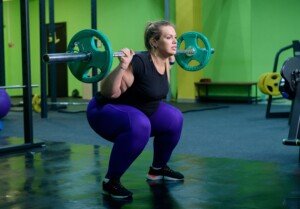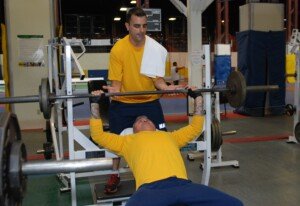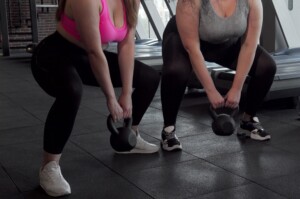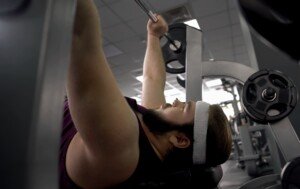If aerobic exercise is too uncomfortable due to your size, you can still effectively lose weight with another form of exercise that’s much easier on your joints.
Aerobic or cardio exercise is not essential for your weight loss, even if you’re morbidly obese. Personal trainers have known this for many years.
However, a study at the Exercise Medicine Research Institute showed how effective strength training is for the loss of excess body weight, when combined with smarter eating habits.
The effect that lifting weights (aka resistance training) can have on excess fat is considerable.
Unfortunately, many very overweight people pretty much confine their exercise regimen to some form of cardio, hoping that this will melt off unwanted pounds.
The irony is that cardio exercise can be a lot more uncomfortable than is moving and pushing against resistance.
The ERMI study demonstrated that lifting weights lowers body fat percentage, body weight overall, and whole-body fat mass.
Cardio exercise often brings with it a sense of dread when one walks through the gym doors and eyes the treadmills and elliptical machines.
And if one doesn’t belong to a gym, the idea of having to walk and walk and walk all over the place outside can sometimes be uninviting for various reasons.
If you belong to a gym, the weight equipment is at your back and call.
If you don’t have a gym membership, you can either join a cheap one if money is an issue (these days, gyms offer plans for all budgets, being that running a gym is an extremely competitive enterprise), or, you can do strength training from the comfort of your home.
However, for optimal weight loss results, you’ll want to check into membership options at a gym or recreation center’s weight room, since these facilities have the best equipment for maximum results.
Lifting Weights vs. Cardio Exercise for Safety
Aerobic workouts can put a strain on one’s knees – simply by virtue of carrying one’s entire body weight during the movements. This risk increases the more time one spends moving during the session.
Whereas with weights exercise, the movement is transient, brief and non-erratic.
Aerobic exercise can tempt a very heavy person to do something they shouldn’t be doing to their joints, such as repeatedly stepping up and down on a stool or jogging downhill – both of which will put a lot of force onto the knee joints.
Though strength training moves such as squats and lunges aren’t without a risk for straining a knee joint, the risk of “blowing out a knee” can be made much smaller doing controlled movements with excellent form.
Benefits of Strength Training for Obese People
• Very heavy people are on an even playing field with thinner exercisers.
This eliminates the temptation for a heavy person to compare their movements to those of a slimmer person. As a result, adherence to the regimen can be much easier.
• Strength training is an on and off type of workout, where you may be executing the exertion for maybe 25 to 45 seconds at a time, with a rest of anywhere from one minute to a few minutes.
These breaks will be very welcome for someone who finds it difficult to use a cardio machine for a nonstop 30 minutes, let alone 45 minutes.
• Less self-consciousness. Many overweight people feel self-conscious when using a treadmill, especially jogging on one, or when using other cardio machines, since these machines are usually used by straight size or thinner exercisers.
But when one sits down on a weight machine and begins pulling the handles towards them, lifting up the stack of metal plates, they’re less likely to think, “Everyone’s watching me.”
• Intense, compound strength training will build lean, fat burning muscle. When combined with a sensible caloric reduction, this duo will incite safe weight loss plus a firmer looking body.
Below Are Ideal Strength Training Exercises for Obese People

Deadlift. Shutterstock/Everyonephoto Studio

Back squat. Shutterstock/Reshetnikov_art

Incline press

Overhead press

Kettlebell workout. Shutterstock/Nata Kotliar

Bench press

Lat pull-down. Shutterstock/Monkey Business Images

Seated row. Shutterstock/Microgen
 Lorra Garrick is a former personal trainer certified through the American Council on Exercise. At Bally Total Fitness she trained women and men of all ages for fat loss, muscle building, fitness and improved health.
Lorra Garrick is a former personal trainer certified through the American Council on Exercise. At Bally Total Fitness she trained women and men of all ages for fat loss, muscle building, fitness and improved health.









































